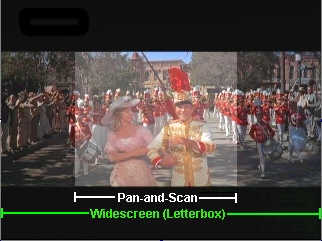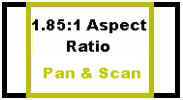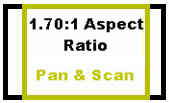| The pan-and-scan area (lighter shaded) is what is shown when your TV screen is full. Wide screen videos and DVDs - even with the black areas - let you see the entire visual image just as it was originally shown in the theatres. |  |
Wide Screen (or "Letterbox") is a way of watching a movie on your TV as the movie was originally shown in the theaters. A normal television has a screen ratio of 4:3 also called 1.33:1. This means that the TV is 1.33 times wider than it is high.
The example below is a screen shot from the
wide screen version of The Music Man, courtesy of Warner Bros.
| The pan-and-scan area (lighter shaded) is what is shown when your TV screen is full. Wide screen videos and DVDs - even with the black areas - let you see the entire visual image just as it was originally shown in the theatres. |  |
Most movies are filmed in a format where they were shown in ratios of 1.66:1 all the way up to 3:1 where the movie was three times as wide as it is high. Unfortunately, because TV screens are not that wide, we have been subjected to movies having visual portions completely cut off so that the image will fit on our screens.
This is where wide screen videos and DVDs come into play. The wide screen transfer process actually shrinks a movie down so that the entire visual image fits on your television screen. This results in what are inaccurately called "black bars".
Cinerama
2.77:1 to 3.00:1 aspect ratio. When transferred to video in its full ratio, this format produced the most "letterboxing" effect. This method of filming actually used three cameras, after which the three images were interlocked together. Any transfer to video (and the only one is "How the West Was Won") would be from a 35mm 'scope reduction print and therefore have a 2.35:1 ratio.

CinemaScope
2.35:1 (originally 2.66:1) aspect ratio. This was once the most commonly used method of filming movies because its only major requirement was a special CinemaScope projector lens, which was available at virtually every movie theatre. CinemaScope was originally created by 20th Century Fox, but it is no longer in use by studios other than Fox. All of the original 3 "Star Wars" movies and even the 1997 animated version of "Anastasia" were filmed in CinemaScope.

Panavision
2.40:1 aspect ratio. The Panavision company became the most successful maker of wide screen lenses, and in the 1970s their Panavision lenses became the "standard" for wide screen. Panavision still makes the lenses for most of the major studio productions today. Panavision also makes lenses for films made with matting as opposed to true wide screen. These matted films are not necessarily 2.40:1, but are most likely 1.85:1.


VistaVision
1.70:1 aspect ratio (approx.). This one was filmed with a specially designed camera which was mounted on its side and it required a special projector, but its image quality was better than standard 35mm.
Films shot in VistaVision were photographed on a double width frame of 35mm running right to left horizontally. The uncropped aspect ratio was 1.5:1. The films were generally reduction printed to 35mm 4-perforated (four sprocket holes per frame) in dye-transfer Technicolor and projected with a 1.85:1 ratio - the image area extracted optically from the full frame. For some special venues the double-frame 35mm film was cropped to 1.85:1 during projection.

Todd-AO
2.2:1 aspect ratio during filming, but 2.35:1 after the transfer to a 35 mm print. This process uses a 65mm negative printed onto 70mm film, with a six-track soundtrack, producing a very high quality picture. Many of the great epics and musicals of the 50s and 60s used this format.
Technirama
2.2:1 (70mm prints) or 2.35:1 (35mm prints). This process was developed by the Technicolor Corporation, as a way to continue using its three-color process in the wake of competing Eastman Color. It required both a specially developed sideways camera (like VistaVision) and a wide screen lens (like CinemaScope).
Technirama was shot with VistaVision cameras and an anamorphic lens squeezing the image by 25%. The entire 1.5:1 image area was then either optically unsqueezed to 70mm yielding a 2.21:1 aspect ratio, or given an additional squeeze to 35mm 2.35:1 4-perforated (four sprocket holes per frame) Panavision.
Academy
1.33:1 aspect ratio. The Academy ratio (1.37:1 before a soundtrack was incorporated onto the film) was the primary original aspect ratio. Most movies (if not all) that were released before "The Robe" (the first movie to be shown in wide screen) were shown in this ratio.
When televisions first came on the scene, they were (and still are) designed with an aspect ratio matching the Academy ratio so that movies would be shown in the same way as in the theatres. Movies that were filmed in an Academy ratio will not have a "wide screen" version because they fit perfectly on the TV. Such movies include "The Wizard of Oz", "Casablanca", "Citizen Kane", and many, many others.
Super 35
This process does not involve wide screen lenses, but rather it involves framing the picture to fit the ratio of the screen. The top and bottom of the frame are "matted" out and removed from the picture completely, resulting in a rectangular picture. Many movies made in this format are transferred to video with the top and bottom of the frame *restored,* so that you actually see more of the picture on video than you did in the theater.
But this is not always a good thing, because the director did not intend to use the top and bottom of the frame in the first place! This is why people talk about boom mikes appearing on video, when they were never there in the theater. However, in almost all circumstances, scenes which include special effects in them are almost always filmed hard-matted in the appropriate wide screen ratio.